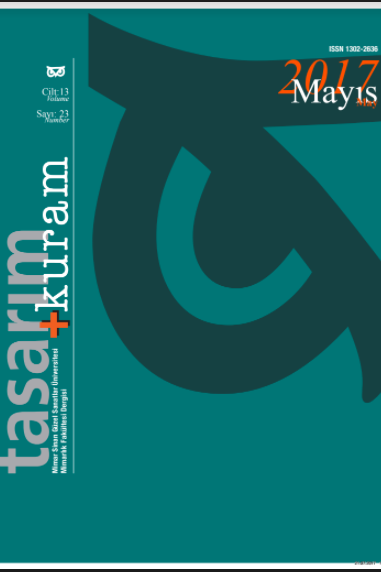Sibertektonik Mekân
“Sibertektonik Mekân”, sibernetik bilginin mekânın tektoniğine eklemlenmesi ve bu çok katmanlı yeni mekânın bedene eklemlenmiş sibernetik uzantılarla kavranabilmesi sonuncunda “yeni” bir mekân deneyimi sunmaktadır. Bu çalışma ile insanın mesken tutma/varoluş sürecinde, gelişen yeni teknolojiler ve arayüzler doğrultusunda mimarlığın temel sorunsalı olan mekân ve mekânsal deneyim bağlamında açığa çıkma potansiyeli olan “yeni”nin ipuçlarını araştırılmıştır. İnsanın mesken tutma/ varoluş sürecinde “Sibertektonik Mekân”ın yerinin mimarlık bağlamında araştırılması, yorumlanması ve anlamlandırılmasının önemli olduğu düşünülmektedir. “Sibertektonik Mekân”a ilişkin araştırmanın kuramsal perspektifinin geliştirilmesinde Sanallık Gerçeklik Paradigması, Sibermekân Olgusu, Beden Mekân Deneyimi ve Uzantı Olgusu, Olay- Mekân-Eylem Örüntüsü kavramları temel kurguyu oluşturmaktadır. Bu kurgu bağlamında gerçekleştirilen uygulamalar ile araştırma sürecinde sibertektonik mekan kavramı anlamlandırılmaya çalışılmıştır. Mevcut bir fiziki mekâna müdahale ederek, sibernetik öğelerle artırılmış bir mekân deneyiminin keşfedildiği Mekan +: Kütüphane, Mekan +: Sergi, Mekan +: Kampüs uygulamaları ile “Sibertektonik Mekân”ın sunduğu yeni mekan deneyimine dair olasılıklar, ilk elden deneyim ve katılımcı gözlem yöntemleriyle elde edilen bilgi ve deneyimler yorumlanmıştır.
Anahtar Kelimeler:
Beden, Mekan, Olay, Sanallık, Artırılmış Gerçeklik
The “Cybertectonic Space” provides a new experience of space, where cybernetic data is embedded into the layers of space. This multilayered space can only be experienced through bodies which are extended with cybernetic extensions. This study seeks the indications of emerging space which is becoming possible with new technologies and interfaces, through the continuous process of human dwelling and being regarding architecture’s main problematic; space and spatial experience. The concepts of Reality-Virtuality paradigm, the phenomenon of Cyberspace, Body-Space experience, the notion of extension and Event-Space-Action patterns create the main structure to develop a theoretical framework for Cybertectonic Space research. Applications have been implemented to make a sense of the concept of Cybertectonic space. Space+:Library, Space+:Exhibition and Space+:Campus projects intervenes an existing physical space with cybernetic elements. Extracted data and experience gained through the methods of firsthand experience and participant observation through these projects are being interpreted within the conceptual framework Cybertectonic Space
Keywords:
Body, space, event, virtuality, augmented reality,
___
- Azuma, R. T. 1997. A Survey of Augmented Reality. Presence-Teleoperators and Virtual Environments 6(4): 355–385.
- Baudrillard, J. 1994. Simulacra and Simulation. Michigan: University of Michigan Press.
- Deleuze, G. 1968. Difference and Repetition. London: Continuum Intl Pub Group.
- Deleuze, G. 1988. Bergsonism. New York: Zone Books.
- Deleuze, G. 2002. Actual and the Virtual. Dialogues II. New York: Continuum Intl Pub Group ss. 2–6.
- Deleuze, G. 2003. Francis Bacon: The Logic of Sensation. DW Smith, London: Continuum.
- Deleuze, G. ve Guattari, F. 1987. A Thousand Plateaus. London: University of Minnesota Press.
- Eco, Umberto. 1987. Travels in Hyper-reality. London: Picador.
- Heidegger, M. 1971. Poetry, Language, Thought. New York: Harper & Row.
- Heim, M. 1993. The Metaphysics of Virtual Reality. Oxford: Oxford University Press.
- Hubert, C. 2006. Hypertext. [çevrimiçi] Eriflim Yeri: http://christianhubert.com/writings/index.htm: [eriflim tarihi: 10.02.2013].
- Lacan, J. 1977. The Four Fundamental Concepts of Psycho Analysis. London: Hogarth.
- Manovich, L. 2002. The Poetics of Augmented Space:
- Learning from Prada. Içinde: A. Everett ve J. T. Caldwell (Ed.). New Media: Theories and Practices of Digitextuality: 75–92.
- McLuhan, M. 1964. Understanding Media The Extensions of Man. London: McGraw Hill.
- McLuhan, M. ve Fiore, Q. 1967. The Medium is the Mas- sage: An Inventory of Effects. Media. Corte Madera.CA: Gingko Press.
- McLuhan, M., McLuhan, E. ve Zingrone, F. 1995. Essential McLuhan. New York: Basic Books.
- McLuhan, M. ve Powers, B. 1989. The Global Village: Transformations in World Life and Media in the 21st century. New York: Oxford University Press.
- Merleau-Ponty, M. 1962. Phenomenology of Perception. Cognitive Science. London: Routledge.
- Merleau-Ponty, M. 2004. The World of Perception. Journal of the Electrochemical Society. London: Routledge.
- Milgram, P., Takemura, H., Utsumi, A. ve Kishino, F. 1994. Augmented Reality: A Class of Displays on the Reality-Virtuality Continuum. Proceedings of Telemanipulator and Telepresence Technologies. Citeseer C. 2351: 282–292.
- Mitchell, W. J. 2000. E-topia: “Urban life, Jim--But Not as We Know It”. London: MIT Press.
- Nelson, T. 1965. Complex Information Processing: A File Structure for The Complex, The Changing and The Indeterminate. Proceedings of the 1965 20th National Conference. Cleveland : 84–100.
- Pesce, M. 1995. Ontos, Eros, Noos, Logos. Keynote Adress at ISEA (International Symposium of Electronic Arts).
- Seamon, D. 1979. A Geography of the Lifeworld: Movement, Rest and Encounter. London: Croom Helm.
- Shusterman, R. 1997. Somaesthetics and the Body/Media Issue. Body & Society 3(3) :33–49.
- Sterling, B. 1992. The Hacker Crackdown. New York: Bantam Books.
- Zizek, S. 2002.İdeolojinin Yüce Nesnesi. İstanbul: Metis.
- ISSN: 1302-2636
- Başlangıç: 1999
- Yayıncı: Mimar Sinan Güzel Sanatlar Üniversitesi
Sayıdaki Diğer Makaleler
Yerelden Kopmak ve “Başka Yerde Mimarlık”
Endüstriyel Tasarımda Paradigma Kaymaları İşlev/Anlam İkiliğinin Aşılmasına İlişkin Bir Öneri
Sıdıka Benan ÇELİKEL, Semra AYDINLI
Bitişik Ekosistemler Arasındaki Sınırlar: Ekolojik Geçiş Zonları
Seher Demet YÜCEL, Güzin KONUK
Serhat KUT, Semra AYDINLI, Arzu ERDEM
Kayseri Kırsalı’ndaki Yığma Konutlar İçin Duvar Tipi Önerisi
